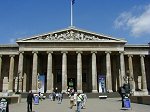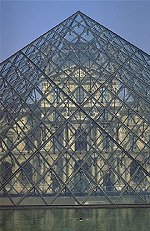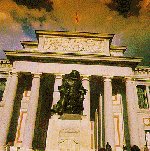|
MUSEUM - A SPLITTING AT THE BORDER OF
THE PRESENT AND THE PAST
by László Rajk
The splitting always occurs on the side of the present, that's why it is arbitrary, we could say violent. We might not get an objective, full picture through it, since we can only see one segment of the past. We can increase the number of the splitting and enlarge their extension, however, an arbitrary interference into time will always influence our past. The cutting is always a print of our present on the past. Moreover, the cuttings are also separated by time, in other words, with the emergence of each new segment of the past, another present will influence our image of it. It is even so if each of the segments try to focus on the same moment of the past.
Thus, a museum's continuity that is rooted in the past doesn't only prove to be a paradox when contemporary art is presented but it results from itself. The museum - just like everything else around us, including ourselves - is in a state of constant change.

British Museum London
A museum is like the technique of the seven veils
Old masters often applied the technique mentioned in the title, when they taught drawing. The main point about this technique is to teach the kind of artistic approach of drawing, according to which a piece of art should always look complete, in each phase of its creation.
Let us imagine seven veils between model and artist. The artist would first draw what he sees blurred, through the seven veils, in the next phase, after removing one veil, he completes the drawing further, by looking at it through the remaining six veils. The main idea of this technique is that a full, complete picture should be drawn during each of the "veil-phases". The technique is not really professional, it rather belongs to the arsenal of hobby-painters, but it is not to contempt either, and it is applicable in this case.
An exhibition must indeed be prepared for 30-, 40-minute, or even 2-hour conducted presentations and at the same time it must satisfy the demands of a thorough visitor or researcher too. Moreover, everyone is supposed to have the full experience.
A museum is like a hologram
The Hungarian, Nobel-prize winner Dénes Gábor, who lived and worked in England once quoted an ancient Greek axiom with reference to his invention. There is a drop in the sea, and the sea is in the drop. When we "break" a holographic picture into pieces, each of the pieces will contain the complete information about the picture, and by putting more and more pieces together the sharper and more lifelike picture we will get.
So, by observing any of the displayed exhibits, the visitor will gain information about the whole museum. We must realise that the displayed objects cannot be put into a totally neutral environment. Our perception is influenced by the lighting, its source, the colour and texture of the walls, the floor, the fabric of the ceiling, in other words, by the constructed, artificial environment.
It is undeniable that the environment that surrounds the exhibit, together with the exhibit itself will shape our perception of the museum. (Not to mention the outer design of the building, its place in the town's structure, or its presentation in a virtual space.)
Thus, by inspecting each of the exhibits, the visitor can form an idea about the entire museum and its artistic approach. The more he becomes absorbed in the displayed exhibits, the clearer picture he will get about the collection, its goals, and last but not least, about the complex conception of the museum.

Paris - Louvre
The building of a museum in the city's structure is like a golden diamond ring
The setting, the golden ring, the environment of the diamond is important but the "protagonist" is the diamond. However, it is not irrelevant who is wearing it. More precisely, what is the golden ring's style, does it match its wearer's cloth, or the occasion? We could say the diamond is valuable in itself but its setting is the wearer's artistic approach.
The city is the wearer of the jewel, the museum is the ring, and the diamond is the collection of the museum. As it is often quoted with reference to haute couture, the museum (the golden diamond ring) is the city's accesoir.
A museum is not based on the idea of a fortified treasury but on an open house
The museum doesn't only preserve treasures but it must display them as well. It is like our home, which provides shelter for the inhabitants but it is open to the guests we invited. A house is not called open because it has large windows but because it is inviting, hospitable, cosy, in other words, human.
The building of the museum doesn't follow the idea of "my house, my castle" but it is a place where our common treasures are displayed.
Although the origins of museums are based on the passionate but modest private collections, the basic conception of the museum has radically changed. Even the large and famous private collections make efforts that the visitors should consider the displayed collection a public property. Not to mention, that the private collector's role has been almost entirely taken over by the different local, state, international or virtual communities.
Thus, the house is not "my castle" hereafter, but our castle, whose building (as it usual in case of new houses) is influenced by all of us even if indirectly. A place that displays common property should serve public interest with the only completion that the exhibits should play the main role.
The building of the museum is not the cloister of the lonely professional researcher but a place where the present and the past are interrelated in an interactive way.
Together with the idea of a museum was a technique born that based the search of the past on the literal instead of the verbal heritage. Thus, museums did not only become places of exhibition but researching centres too. Different eras interpreted and managed this double function differently. The double function is valid even today, but the balance between the two is ever more fragile, and the public should be provided more extensively with the newest findings. Beside research, the quickest possible publication of its results is becoming essential. Moreover, the public is less and less willing to accept the one-way information flow (from the researcher to the public) and demands more and more interactivity.

Madrid: Prado
Finally, the dilemma of the outsider (if the architect is one)
The architect must almost always fight with his interfering role that is a result of his profession. For how long can he consider himself a connoisseur and from which time does he become alienated from the environment he designed? It is possible that it occurs in the neighbouring street and district or in a different town, street or even continent. The answer could be various for and against. To avoid a strict yes or no answer, let us consider other factors too, for instance globalisation, locality, the increased co-operation, multiculturalism, the tracing down and acceptance of local partners, the research work, the co-existence with the local community etc. Beside the many obvious explanations, let me emphasise something that might seem overconfident, yet it is honest and clear.
The dilemma of the researcher is, to what extent should he identify and be emphatic with the objects and people of his research work? The answer is seemingly simple, namely, the more the better. However, the answer is far more complex than that. An exaggerated empathy could badly influence our objectivity.
Thus, the architect must be like a researcher who keeps a distance between himself and the object of his research, taking all of its virtues, beauties and failures into account. Since the environment, the city for instance must be taken into consideration too, the architect has to accept and emphasise them, on the other hand he has to change them by correcting the failures.
Translated by: Monika Rees
|